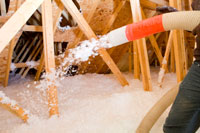Do-It-Yourself Home Energy Audits, Part 2: Checking Insulation
 When conducting a do-it-yourself home energy audit as part of an effort to cut your cooling costs this summer, the first thing you want to do is detect air leaks and seal them. After you’ve done that, you’re ready to check your home’s insulation, which plays a critical role in your home’s overall energy efficiency.
When conducting a do-it-yourself home energy audit as part of an effort to cut your cooling costs this summer, the first thing you want to do is detect air leaks and seal them. After you’ve done that, you’re ready to check your home’s insulation, which plays a critical role in your home’s overall energy efficiency.
If your home is older or has insulation levels that are less than today’s recommended minimum, you could be losing cooled air through the attic, ceiling, and walls at a relatively rapid pace. To help shore up your insulation and prevent heat loss, you’ll need to check the insulation in your attic and walls.
Checking the Insulation in Your Attic
When checking your attic for proper insulation, make sure to inspect the hatch; openings for pipes, ductwork, and chimneys; vapor barriers; areas around vents and electrical boxes; and the attic floor.
Attic hatches should be at least as heavily insulated as the attic itself and should also be sealed with weather stripping so it closes tightly.
Gaps around openings for pipes, ductwork, and chimneys should be sealed tightly with an expanding foam caulk or another permanent sealant.
A vapor barrier is critical for reducing the amount of water vapor that can pass through your ceiling, which can reduce the effectiveness of insulation and cause structural damage over time. Check underneath your attic insulation for typical vapor barriers such as a layer of tarpaper, Kraft paper attached to fiberglass batts, or a plastic sheet. If you don’t have a vapor barrier you’ll need to add one. If it’s in bad shape, you’ll need to replace it.
Areas around vents and electrical boxes need to be sealed tightly. Use flexible caulk to seal any gaps or cracks, from either the living room side of the attic side. And make sure that attic vents are not being blocked by insulation.
Your entire attic floor needs to be covered with at least the current recommended amount of insulation, which is based on your home’s material construction and the part of the country in which you live. For more information, check with a professional insulation contractor.
Checking the Insulation in Your Walls
Checking the insulation in your walls is a little more difficult than checking it in your attic. For the best DIY results, just follow these simple steps:
- Choose a wall to check
- Turn off the circuit breaker or unscrew the fuse for any electrical outlets that are in the wall
- Test to make sure the outlets are not hot by plugging in a lamp or some other device and turning it on if it doesn’t work, the outlet is cold and isn’t getting any electricity
- Once the outlets have been tested and verified cold, remove the cover plate from one outlet and gently probe into the wall with a thin stick or long screwdriver if you feel resistance, there is some insulation in your wall; repeat for other outlets on the same wall if desired
Ideally, each wall should be entirely filled with insulation. Unfortunately, the DIY method for testing wall insulation described above cant tell you if the entire wall is insulated. For that, you’ll need to swallow your DIY pride and hire a professional home energy auditor to perform a thermographic inspection.
A Word on Caulking
When sealing air leaks with caulk, make sure to choose the right kind of caulk and read up on how to apply it correctly.
Do-It-Yourself Home Energy Audits: Air Leaks, HVAC Equipment and Lighting
Make sure to read up on the other steps involved in a four-part DIY home energy audit:
Part 2: Check Insulation
Part 3: Inspect HVAC Equipment
Sources
U.S. Department of Energy, Energy Efficiency & Renewable Energy, Do-It-Yourself Home Energy Assessments.
U.S. Department of Energy, Energy Efficiency & Renewable Energy, Attic Insulation.



